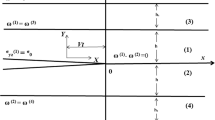Abstract
The existence of viscosity effect at the interface of double dissimilar materials has an important impact on the distribution of the interface crack-tip field and the properties variety of the interface itself. The singularity and viscosity are considered in the crack-tip. The elastic-viscoplastic governing equations of double dissimilar materials at the interface crack-tip field are established. The displacement potential function and boundary condition of interface crack-tip are introduced. The numerical analysis of elastic-viscoplastic/rigid interface for mode III is worked out. The stress-strain fields are obtained at the crack-tip and the variation rules of solutions are discussed according to each parameter. The numerical results show that the viscosity effect is a main factor of the interface propagating in the crack-tip field, and the interface crack-tip is a viscoplastic field governed by the viscosity coefficient, Mach number (Ma), and singularity exponent.
Similar content being viewed by others
References
Williams, M. L. The stresses around a fault or crack in dissimilar media. Bulletin of the Seismological Society of America 49(2), 199–204 (1959)
Gao, Yuli, Lou, Zhiwen, and Du, Qinghua. The problem on the mixed mode interface crack of materials with different hardening indices (in Chinese). Acta Mechanica Sinica 20(4), 375–380 (1988)
Wang, B. L., Han, J. C., and Du, S. Y. Cracks problem for non-homogeneous composite material subjected to dynamic loading. International Journal of Solids and Structures 37(9), 1251–1274 (2000)
Tang, Lihua and Xu, Jinquan. Viscoelastic fields near interface crack tip (in Chinese). Chinese Quarterly of Mechanics 28(1), 116–123 (2007)
Yang, Weiyang, Zhang, Shaoqin, Li, Junlin, and Ma, Yulan. Interface crack problems for mode II of double dissimilar orthotropic composite materials. Appl. Math. Mech. -Engl. Ed. 30(5), 585–594 (2009) DOI 10.1007/s10483-009-0505-z
Chen, Borliang and Lardner, T. J. Two-dimensional cracks at an angle to an interface. International Journal of Solids and Structures 30(13), 1725–1735 (1993)
Wei, Peijun, Wu, Yongli, and Zhang, Shuangying. The shock response of interface crack between dissimilar viscoelastic bodies (in Chinese). Acta Mechanica Sinica 33(1), 109–114 (2001)
Ricci, V., Shukla, A., and Chalivendra, V. B. Subsonic interfacial fracture using strain gages in isotropic-orthotropic biomaterial. Theoretical and Applied Fracture Mechanics 39(3), 143–161 (2003)
Cai, Yanhong, Chen, Haoran, Tang, Liqiang, Yan, Cheng, and Jiang, Wan. The dynamic stress intensity factor analysis of adhesively bonded material interface crack with damage under shear loading. Appl. Math. Mech. -Engl. Ed. 29(11), 1517–1526 (2008) DOI 10.1007/s10483-008-1112-z
Shang, Fulin and Kitamura, Takayuki. Molecular dynamics simulations of interfacial crack nucleation and propagation (in Chinese). Chinese Journal of Theoretical and Applied Mechanics 39(4), 571–576 (2007)
Lü, Nianchun, Yang, Dingning, Cheng, Yunhong, and Cheng, Jin. Asymmetrical dynamic propagation problems on mode III interface crack. Appl. Math. Mech. -Engl. Ed. 28(4), 501–510 (2007) DOI 10.1007/s10483-007-0411-x
Author information
Authors and Affiliations
Corresponding author
Additional information
Communicated by Xing-ming GUO
Project supported by the Ph. D. Programs Foundation of Ministry of Education of China (No. 20060217010) and the Fundamental Research Foundation of Harbin Engineering University (No. HEUFT07005)
Rights and permissions
About this article
Cite this article
Liang, Wy., Wang, Zq. & Yang, Zj. Steady-state growing crack-tip field characteristics of mode III elastic-viscoplastic/rigid interface cracks. Appl. Math. Mech.-Engl. Ed. 31, 227–235 (2010). https://doi.org/10.1007/s10483-010-0210-9
Received:
Revised:
Published:
Issue Date:
DOI: https://doi.org/10.1007/s10483-010-0210-9




